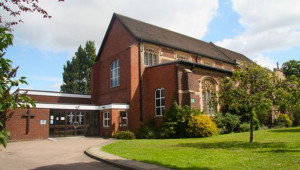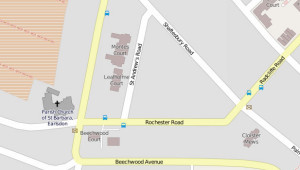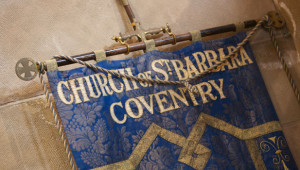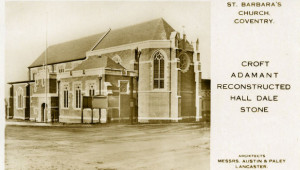St Barbara’s in The Church Today
In the early Catholic Church St. Barbara was one of the 14 auxiliary saints also known as the 14 Holy Helpers, venerated for the supposed efficacy of their prayers on behalf of human necessities. Her feast day was on December 4th though today she no longer has a place in the Calendar of either the Roman catholic or Anglican Churches, though she is still held in high regard on the continent.
Our church is one of only three Anglican churches in England dedicated to her. The other two are at Ashton-under-Hill in Worcestershire and at Haceby (now closed), in Lincolnshire The chapel at the former rocket testing range at Woomera in Australia was dedicated to her and there is a statue of her in the Beauchamp Chapel at St. Mary’s Warwick and in many churches on the continent.
St. Barbara is often depicted holding the palm branch of a martyr and a model of the tower with the three windows. Because of the fatal lightning stroke she is the patron saint of artillerymen and miners and because of the tower she is the patron saint of architects. She has also been shown holding a book. an illusion to her studious life and her name has also been associated with prayers for a good and prepared death, supported by. the Sacraments of the Church:for this reason she is sometimes shown holding a Chance and Host and our own parish emblem is based on a Chalice, Host and Cross.
Before 1852 much of the City of Coventry consisted of overcrowded houses, and filthy streets open to diseases. The open land of fields and common land to the South West of the City was much appreciated by City Folk.
In 1852 An area of some 31 acres was sold by a local farmer and developed into a little estate of 8 streets with 250 building plots.The Earlsdon Estate was born. Many of the residents involved in watch- making or ribbon weaving, were mainly Wesleyan Methodists with no place of worship and the nearest Anglican Church was the Church of St.Thomas at the Butts on the edge of the City that could only be reached by a very round about route or a narrow path by the side of the drainage ditch. Earlsdon was considered to be in the Parish of St. Thomas and on Sunday. 29th May 1853 the first child to be born on the Earlsdon Estate was baptised in St Thomas’ Church.
In 1873 the Wesleyan Methodists transformed an old ribbon factory into a temporary chapel and in 1884 the first Methodist Chapel was built nearby. Not until 1913 was a Mission Church in Palmerston Rd dedicated to St.Barbara by the Lord Bishop of Worcester.By 1921 Earlsdon was growing and the Church Community was growing. and the Church Council agreed to the purchase of a large wooden Building for both Church and Community use. The building came to be called “The tute” and the venture was very successful.
By 1922 Earlsdon at last qualified to become a parish in its own right and with the provision of a church hall the Institute St Barbara’s was becoming a centre of interest and activity. By 1925 the need for an even larger Church was obvious. No site in the centre of Earlsdon was available. but by 1930 a sufficient sum had been raised to consider the purchase of a site where both a new Church and the wooded “Institute” could be accommodated. Thanks to the gifts and donations ranging from hundreds of pounds from Sir Alfred Herbert , the machine tool manufacturer to a shilling or two from workers in the factories the target of £20.000 was reached.
In 1929 work commenced on the site. On Sunday 22nd September,1929 clearing the ground was begun by the cutting of the first sods by Alderman Bates and Messrs Corbett, Johnson and Meadow, all members of the Parochial Church Council.The design of the new church was by Austin & Paley of Lancaster, but the Clerk-of-Works and Consulting Architect for many of the interior fittings was Mr Herbert Jackson, who lived in Huntingdon Rd. Mr Jackson was a man of many parts being a founder member of the Coventry Flying Club,an avid mountaineer (he actually climbed the Matterhorn in his 60 s), and the writer of the definitive book on railway stamps! Even before you enter the church at the west end you can see by its plain brick finish that the church was never completed as originally intended. The architect’s original plans show that, had there been sufficient money then, there would have been an extra bay, two elaborate porches, a baptistry and a bellturret.
The builders, Messrs Harris and Son of Coventry then moved in and started work. Exactly a year later all was ready for the laying of the Foundation Stone in 1930. This ceremony took place on the 28th September, 1930, with Sir Alfred Herbert laying the stone and the whole project being blessed by the Bishop of Coventry, Dr Lisle Carr. Sir Alfred at the same time laid the foundation stone for the Lady Chapel which he was endowing in memory of his beloved wife Florence who had died in the previous June.
On Saturday September 26th 1931 the New Church of St Barbara Earlsdon was consecrated. The Old Church was converted into a parish Hall and was used mainly for Sunday School, Parish meetings and other activities when the Institute moved from Palmerston Rd.
The west end was cut short by 2 bays and a baptistry was never built. The North side of the Church was completed with comparatively cheap brickwork. However The Lady Chapel built in memory of Lady Herbert was completed and contains most beautiful carvings.
During the War from 1939 to 1945 many of the church windows were moved to safety but the Church itself suffered no damage. The Sanctuary was enhanced in 1954 by raising the reredos by 5 feet and around the Sanctuary a carved and painted frieze relating to the 4 seasons carved and painted by Waiter Ritchie was incorporated in 1954.
In June 1971 A new Parish Hall was built at the west end of the Church to replace the old Wooden “Institute” and a new Vicarage was also built next to the Church.
The years since the New Church was built have seen many changes, The Church Hall continues to serve the wider Community as well as the Church activities, and the 60’s saw the growing importance of ecumenism and the growing relationship between the five churches in Earlsdon and Chapelfields.






